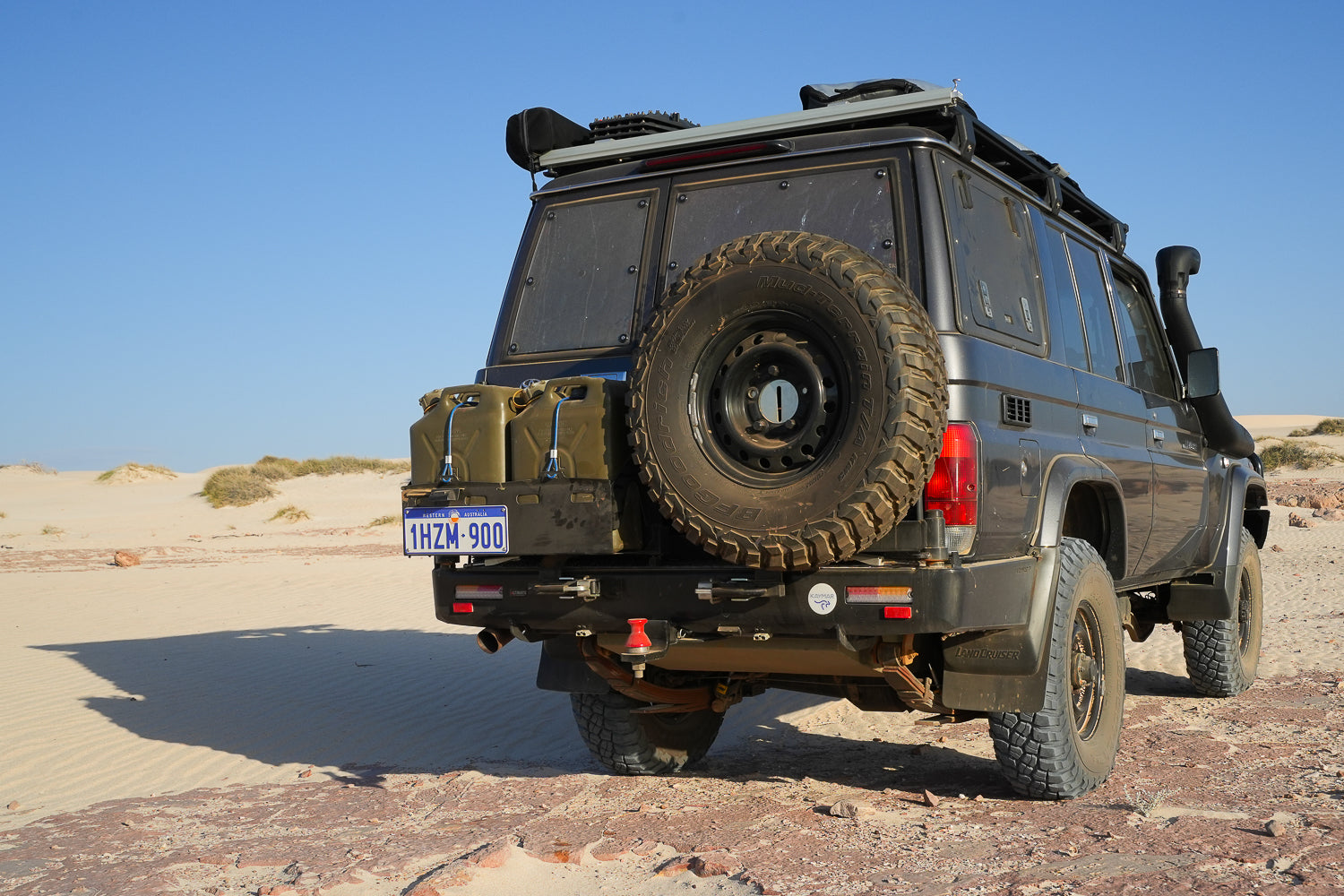I recently switched to a Kaymar rear bar on my 76 Series LandCruiser, and in this piece, I share why I changed and my thoughts on the new bar.

When I originally built my LandCruiser, the shortlist was between the Kaymar that had the reputation of being tried and tested and another brand offering some clever new features.
I chose the latter, and while the ideas were great and the bar was almost there, it ultimately needed more refinements. The manufacturer was open to feedback and implemented design improvements in replacement parts. Still, I decided to switch to an option that hopefully had already gone through the refinement process and wouldn’t require future work.
The second time around, I opted for the Kaymar rear bar primarily based on word of mouth. There are lots of these bars fitted to vehicles exploring rugged areas, and I’ve only ever heard positive feedback.

Like most rear bars, it’s possible to choose different configurations. I settled on a setup to carry my spare wheel on the right and twin jerry can holders on the left. Although I have a 180L long-range fuel tank fitted, I often need more fuel or at least the backup of a jerry can if I’m running the tank low.
I run BFGoodrich KM3 tyres and aim to switch them before they get too tired, and increasingly find one quality spare wheel is enough. On the odd occasion when I’m apprehensive about tyre damage, I can mount a second spare inside the cabin with my second-row seats removed.
One of the unique features of the Kaymar Rear Bar for the 76 Series LandCruiser is the integrated rated tow bar. Like most setups, my previous configuration required a separate tow bar in addition to the rear bar.

In fitting the Kaymar bar, I was hopeful to save some overall weight. I bet the bar would be heavier to accommodate the towing ratings, but I’d still be ahead. I had hoped to be able to share the exact figures with you, but unfortunately, I couldn’t source a load cell in time for the fitting. However, several ‘human scales’ confirmed that my guess was wrong, and the Kaymar bar was lighter than the previous one.
Combining the lighter Kaymar bar with the weight of the removed tow bar was a solid saving I wasn’t expecting!
One of the other benefits of the integrated tow bar is the improved rear departure angle. This bar is about the sweet spot between rear clearance and fuel tank protection and is as good as I’ve seen for this vehicle.
This protection extends the entire length to the rear of the mudguard. It’s an area that can be damaged, so it's good to have the extra protection.

The rear swing arms swivel on smooth hubs and stay in the open position with assistance from stainless steel gas struts. The gas struts do have a simple lock open mechanism that would help on a steep side slope, but I’m yet to need these.

The spare wheel holder is adjustable to accommodate a variety of tyre sizes. With my relatively skinny 25585R16s, I could position the tyre hard against the post to get the weight forward.

I recently ran my GME 4G antenna to free up space on my bull bar for my safety flag and to have a clear view from the driver’s seat. The spare wheel post has a few mount holes for some of the Kaymar accessories, and it was possible to bolt straight into one of these.
The twin jerry can holders are sturdy and perfectly accommodate our Scepter MIL-SPEC Jerry Cans. The supplied cables are attached at one end, making it easy to secure your fuel with a padlock.

These cables are supplied at length to accommodate every jerry can and were a bit long for my setup. I borrowed some heavy-duty wire rope cutters and a quality swage tool from my local chandlery, Yacht Grot, and shortened these so they now offer security and act as a strap to restrict upward movement.
To secure the jerry cans, I used the MAXTRAX MAXLOX 30. It’s a quality stainless steel lock, and the rubber cover is good protection as the lock and rear door occasionally touch.
One of the most significant differences between my previous bar and the Kaymar bar is how easy it is to swing away the jerry cans and spare wheel. The latch is superb quality and incredibly easy to operate one-handed.

While this sounds like a simple detail, I’m sure if you’ve operated a few different mechanisms, you will know they aren’t always easy. The latch on my camper trailer is super hard to open, and on my previous bar, it featured a slam latch that required two hands to open and then a manual pin to keep it open, and the pin needed to be swivelled just so to avoid cracking my brake light cover.

The Kaymar rear bar seems exceptionally well made. In switching, I’ve managed to save weight and improve my rear departure angle, and it is far easier to swing the rear arms out and access my gear.

While it’s still in the early days with the bar, it’s performed flawlessly in dust and over corrugations with full jerry cans on its first two big trips. The design seems simple and the engineering solid, so I’m hopeful of many trouble-free years of travel.
To learn more visit Kaymar. Thanks to the crew at Ultimate 4WD for installing my rear bar.

